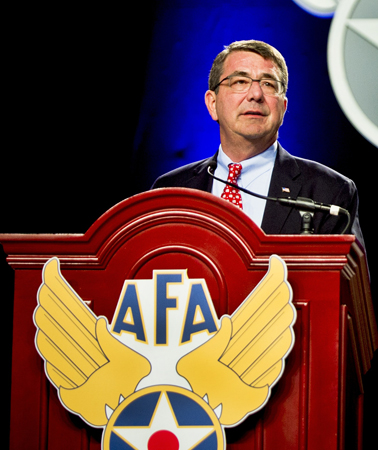The  Air Force is well aligned with the new national strategy, the first tenet of which is “to continue to invest in future-focused capability,” said Deputy Defense Secretary Ash Carter. Addressing AFA’s Air & Space Conference in National Harbor, Md., on Sept. 19, Carter said the future force has to be “agile,” “lean,” and “ready” as well as “technologically advanced.” It must also be “able to defeat any adversary, anywhere, anytime,” he said. The Air Force is “well suited” to such a strategy, said Carter. However, “our newest investments have the shallowest roots,” he warned. “It’s easier to tear them up when we need to make cuts, but we can’t afford to lose our technological edge by cutting the seed corn. The Air Force understands this better than almost anyone,” he added. That’s why the Air Force has the green light to reduce force structure, so it can invest in “cyber, space, electronic warfare, unmanned aerial vehicles, the long-range-strike family of systems, all of which are so important to the Air Force and . . . our future operations,” said Carter. The Defense Department will also support science and technology funding “across the board,” he noted.
Air Force is well aligned with the new national strategy, the first tenet of which is “to continue to invest in future-focused capability,” said Deputy Defense Secretary Ash Carter. Addressing AFA’s Air & Space Conference in National Harbor, Md., on Sept. 19, Carter said the future force has to be “agile,” “lean,” and “ready” as well as “technologically advanced.” It must also be “able to defeat any adversary, anywhere, anytime,” he said. The Air Force is “well suited” to such a strategy, said Carter. However, “our newest investments have the shallowest roots,” he warned. “It’s easier to tear them up when we need to make cuts, but we can’t afford to lose our technological edge by cutting the seed corn. The Air Force understands this better than almost anyone,” he added. That’s why the Air Force has the green light to reduce force structure, so it can invest in “cyber, space, electronic warfare, unmanned aerial vehicles, the long-range-strike family of systems, all of which are so important to the Air Force and . . . our future operations,” said Carter. The Defense Department will also support science and technology funding “across the board,” he noted.
Trainees in Basic Military Training and technical school no longer have the option to try alternate PT drills if they fail an initial assessment, according to a policy change the Air Force made in April. The move is part of a larger shift out of the classroom and into hands-on,…